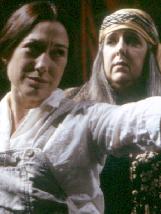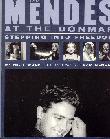SEARCH CurtainUp
REVIEWS
FEATURES
NEWS
Etcetera and
Short Term Listings
LISTINGS
Broadway
Off-Broadway
BOOKS and CDs
OTHER PLACES
Berkshires
London
LA/San Diego
Philadelphia
Elsewhere
QUOTES
On TKTS
LETTERS TO EDITOR
FILM
LINKS
MISCELANEOUS
Free Updates
Masthead
NYC Weather
Silver Nitrate
|
I started with actual photographs from the period, treating them almost like archeological fragments. Characters and relationships emerged out of the physical process of re-making these images. . . --- Cathy Caplan, about how she went about writing Silver Nitrate. |

(l-r) Meg Gibson as Tina Modotti & Aviva Jane Carlin as The Countess
(Photo: Cathy Caplan) |
Cathy Caplan is a playwright with a fertile imagination and an obvious interest in artists. Her first play, Lapis Blue Blood Red, dramatized the story of the 17th century painter Artemisia Gentilesch. In Silver Nitrate (named for the powdery substance that is employed in the photo manufacturing process), Ms. Caplan uses some of the most famous photographs created as part of a movement known as "Neue Sachlichkeit" or "New Objectivity" to jumpstart her fictional account of their creators' zeitgeist. By transporting us into three Berlin studios she allows us not just to watch the photos being re-created but to get to know the artists and be caught up in the unstoppable march of an oppressive regime and its effect on their lives.
The photo sessions begin in a table top studio (a term for advertising photography) where Ernst (Robert Boardman) an older, master of the camera and Anne, his assistant (Katie Kreisler), meticulously and painstakingly arrange a still life with a fish and as the central image (the program includes a reproduction of the source photograph: "Good Friday Snack" by Walter Peterhans). The highly technical shoot turns into the beginnings of a story with the arrival of Lotte (Samantha Soule), a young sculpture student who, eager to learn the intricacies of a more timely craft, volunteers her services. Next we meet Marta (Chandler Vinton) and Helmut (Jordan Meadows) whose partnership is rife with sexually tense underpinnings. From there it's on to the celebrity portrait studio of a charismatic woman identified as The Countess (Aviva Jane Carlin), her son Peter (Pierce Cravens) and a politically exiled photographer named Tina Modotti (Meg Gibson) who asks the Countess to let her share her studio space.
Each studio is a world onto itself but as succeeding visits to each makes increasingly clear none of these inner sanctums is likely to survive without being touched by the turmoil boiling up on the streets of Berlin. The fact that these separate and distinct partnerships all play out against the same historic background is reinforced by the repetitive pattern of Caplan's story telling -- the back story for the photograph followed by a projection of the finished photo on the curtained backdrop.
The roundelay of repeated brief stops at each studio makes for a leisurely build-up of the stories. Anne and Lotte from the Table Top studio decide not to follow Ernst to a prestigious post with the Bauhaus Institute but to carry on at the studio. Two years later, their successful partnership falls victim to the Editorial Act which barred Jews from working as photographers, editors and journalists (two years before German Jews lost the right to vote). This decree has equally disastrous consequences for the Countess and young Peter who once thought it would be fun to joke around with the youths who were members of the Brown Shirts. The changing political climate also brings Martha and Helmut's differences to a head.
In one of the play's most dynamic scenes the whole cast is on stage for an art exhibit of Tina's work. Effective as this episode is, it also makes the return to the individual scenes seem suddenly static and anticlimactic -- but only briefly. Still to come is the devastating denouement in which all but a few of the actors model for a head shot photo that, unlike the ones so artfully executed before, is a quick, standard issue affair to be used for the same basic last train from Berlin purpose.
Under Gwynn MacDonald direction the transitions from one short scene to another are smoothly executed and the actors are encouraged to develop their characters as carefully as the images in the photograph the characters take and pose for. Aviva Jane Carlin, who impressed me enormously in two other Off-Off-Broadway appearances (Jodie's Body and Sitting Pretty), again proves herself to be an actress with the sort of presence that immediately imbues everything that's happening on stage with an extra flutter of excitement. Meg Gibson as the more political counterpoint to the apolitical Countess is another standout in the generally praiseworthy ensemble.
Anyone reading this who's ever been to the New Heron will appreciate that it's quite a feat to create so many scene changes on this small stage. Set designer Curtis Wallin's minimalist approach with its focus on several draw-back curtains accommodates the scene-to-scene shifts without fuss. The shift in mood as well as location is subtly enhanced by Tyler Micoleau's lighting. Loren Bevans has provided an amazing number of costume changes to fit the characters and the time; yet another contribution to the play's visual pleasures.
Lisa Dove's between scene music for cello and piano-accordion and voiceadds to the Weimar aura flavor. However, while accordionist and singer Tatjana Cornij has a nice voice, her delivery of the lyrics based on essays and manifestos makes one wish that the words were, like the photos, projected or, alternatively, printed in the program.
My major regret, now that I've seen this play, is that I missed Caplan's previous outing with Juggernaut Theatre Company. I've learned my lesson and won't let any future plays from this talented young playwright or this company slip past my radar. I suggest that you don't either.
| Silver Nitrate Written by Cathy Caplan Directed by Gwynn MacDonald Cast: Robert Boardman, Aviva Jane Carlin, Pierce Cravens, Meg Gibson, Katie Kreisler, Jordan MeadowsSamantha Soule, Chandler Vinton Set Design: Curtis Wallin Costume Design:Loren Bevans Lighting Design: Tyler Micoleau Composer : Lisa Dove Accordionist/Singer: Tatjana Cornij Running time: 90 minutes, without intermission Juggernaut Theatre Company at Blue Heron Arts Center, 123 E. 24th St.323/868-4444 10/14/03 to 11/16/03; opening 10/21/03 Tue - Sat at 8pm, Sat - Sun at 3pm -- $25 Reviewed by Elyse Sommer based on Ocotber 19 press preview |

Mendes at the Donmar
Our Review

At This Theater

Leonard Maltin's 2003 Movie and Video Guide

Ridiculous!The Theatrical Life & Times of Charles Ludlam

Somewhere For Me, a Biography of Richard Rodgers

The New York Times Book of Broadway: On the Aisle for the Unforgettable Plays of the Last Century

6, 500 Comparative Phrases including 800 Shakespearean Metaphors by CurtainUp's editor.
Click image to buy.
Go here for details and larger image.



